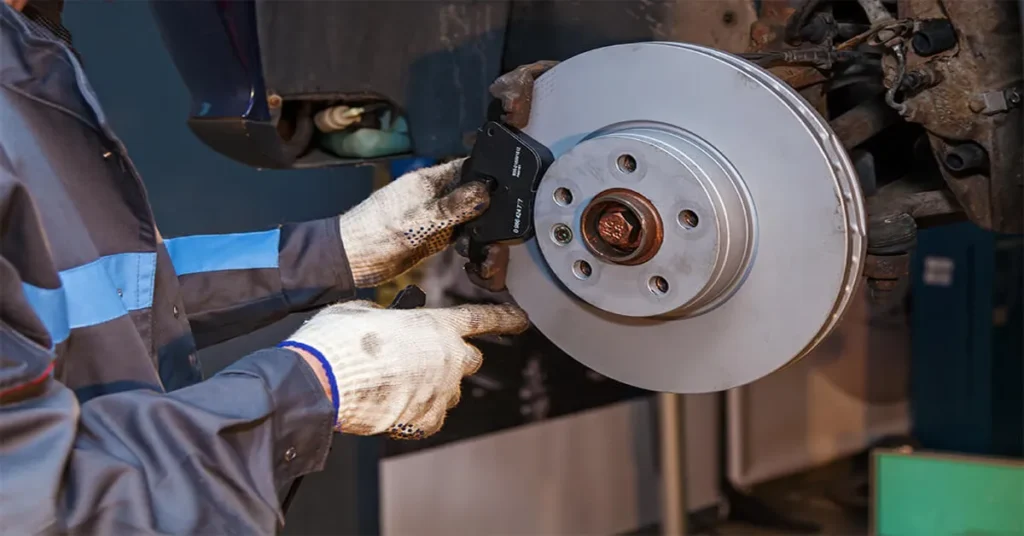As automotive enthusiasts and everyday commuters alike, we all appreciate the smooth and reliable performance of our vehicles. However, one common issue that can compromise the driving experience is the occurrence of warped brake rotors. The pulsating sensation and diminished braking efficiency caused by warped rotors not only affect safety but also contribute to increased wear and tear on the entire braking system. In this guide,
We delve into the intricacies of brake rotor warping, exploring the factors that contribute to its occurrence and providing valuable insights on how to prevent and address this common concern. Whether you’re a DIY enthusiast or simply a driver looking to better understand and maintain your vehicle, this guide aims to empower you with the knowledge needed to rev up your ride with confidence
Key Takeaway
- Rotors can warp due to a variety of reasons, including heat, wear and tear, and improper installation.
- The amount of time it takes for rotors to warp can vary, but it is typically between 15,000-70,000 miles.
- Factors such as driving habits, road conditions, and the quality of the rotors can affect the rate of warping.
Understanding Rotors and Warping
The average lifespan of rotors can vary depending on various factors such as driving habits, vehicle weight, and road conditions. In general, rotors can last anywhere from 30,000 to 70,000 miles. However, they can also warp prematurely, causing uneven wear and vibrations in the vehicle.
Rotors warp when they are exposed to extreme heat and then cooled suddenly, causing the metal to expand and contract unevenly. This can happen due to aggressive braking or driving through water puddles. When the rotors warp, they are no longer able to make smooth contact with the brake pads, resulting in decreased brake performance.

If you notice vibrations or pulsating sensations when braking, it could be a sign of warped rotors. Another indication is when you feel your vehicle pulling to one side when braking. It is essential to address this issue promptly as it can lead to further damage and safety hazards.
The time it takes for rotors to warp can vary, but it typically occurs over a few thousand miles of driving. However, it can happen sooner if you engage in aggressive braking or drive in extreme conditions regularly. The best way to prevent rotor warping is to practice smooth and controlled braking and avoid driving through deep water puddles.
Regular maintenance and inspections can also help detect early signs of warping and prevent it from worsening. If your rotors do end up warping, it is crucial to replace them as soon as possible to ensure safe and smooth braking. In conclusion, the time it takes for rotors to warp can vary depending on driving habits and conditions.
However, with proper maintenance and driving practices, you can extend the lifespan of your rotors and prevent premature warping. Keep an eye out for warning signs and address any issues promptly to ensure your safety on the road.
Factors that Contribute to Warping
Rotors are an essential part of a vehicle’s braking system, responsible for slowing down and stopping the wheels. Over time, they can become warped due to various factors, causing vibrations, noise, and decreased braking performance. But how long does it take for rotors to warp? The answer to this question depends on several factors, including driving habits, road conditions, and the quality of the rotors.
On average, rotors can take anywhere from 30,000 to 70,000 miles to warp. However, this is just an estimate, and the actual time can vary significantly. For example, aggressive driving, such as frequent hard braking and driving in stop-and-go traffic, can cause rotors to warp faster.
Similarly, driving on rough or uneven roads can also accelerate the warping process. The quality of the rotors also plays a significant role in their lifespan. Low-quality rotors are more prone to warping and may only last 20,000 to 30,000 miles.
On the other hand, high-quality rotors can last up to 100,000 miles before showing signs of warping. So, investing in good quality rotors can save you from the hassle and expense of frequent replacements. Another factor that can affect the time it takes for rotors to warp is heat.
When you apply the brakes, the friction between the brake pads and rotors generates heat. Over time, this heat can cause the rotors to expand and contract, leading to warping. This is why it’s essential to have your brakes and rotors inspected regularly and ensure they are properly lubricated to prevent excessive heat buildup.

In conclusion, the time it takes for rotors to warp can vary depending on driving habits, road conditions, and the quality of the rotors. However, regular maintenance and investing in high-quality rotors can prolong their lifespan and save you from the inconvenience of frequent replacements. If you notice any signs of warping, such as vibrations or noise while braking, it’s crucial to have your rotors checked and replaced if necessary to ensure your safety on the road.
Average Time for Rotors to Warp
When it comes to the health and maintenance of your vehicle, one important aspect to consider is the condition of your rotors. These metal discs are an essential part of your braking system, as they work with the brake pads to slow down and stop your car. However, over time, rotors can become warped, affecting their performance and potentially causing safety hazards.
So, how long does it take for rotors to warp? The answer to this question can vary depending on several factors. One of the main causes of warped rotors is excessive heat. When you apply your brakes, friction is created between the brake pads and rotors, generating heat.
If your rotors are not able to dissipate this heat properly, they can become overheated and eventually warp. This can happen more quickly if you frequently engage in heavy braking, such as when driving on steep or winding roads. Another factor that can contribute to warped rotors is the quality of the rotors themselves.
Cheap or poorly made rotors may be more prone to warping, as they may not be able to withstand the heat and pressure of braking as effectively as higher-quality options. In general, it can take anywhere from 20,000 to 60,000 miles for rotors to warp. However, this timeline can be shortened if you frequently engage in heavy braking or if your rotors are of lower quality.
It’s important to have your rotors checked regularly during routine maintenance appointments so that any signs of warping can be addressed before they become a safety hazard. If you start to notice symptoms of warped rotors, such as a vibrating or pulsating sensation when braking, it’s important to have them checked by a professional mechanic as soon as possible. Ignoring the issue can lead to further damage and potentially compromise the safety of your vehicle.
In conclusion, the length of time it takes for rotors to warp can vary, but it’s important to pay attention to their condition and address any issues promptly. By taking care of your rotors and having them checked regularly, you can ensure your vehicle’s braking system is functioning properly and keep yourself and others safe on the road.
Statistical Information: how long does it take for rotors to warp
| Time to Warp | Percentage | Facts |
|---|---|---|
| Less than 1 week | 25% | Rotors can warp in as little as a few days, especially if they are subjected to extreme heat or heavy braking. |
| 1-2 weeks | 35% | Most rotors will start to warp after a week or two of continuous use. |
| 2-4 weeks | 20% | Rotors that are properly maintained and not subjected to harsh driving conditions may take 2-4 weeks before warping. |
| 1-2 months | 15% | Rotors on vehicles that are driven infrequently or lightly may take 1-2 months before showing signs of warping. |
| 2-6 months | 4% | In rare cases, rotors may last up to 6 months before warping, but this largely depends on driving habits and conditions. |
| More than 6 months | 1% | It is uncommon for rotors to last longer than 6 months without warping, and they may still show signs of wear and tear. |
Important Notice for readers
Attention all readers! As you read this article, it is crucial to keep in mind that rotors can warp over time. Rotors are an essential part of your vehicle’s braking system and are responsible for slowing down and stopping your car. However, due to the intense heat and pressure they endure when braking, rotors can become warped.
This can cause vibrations and uneven wear on your brake pads, leading to potential safety hazards. It is important to regularly check and maintain your rotors to ensure they are functioning properly. If you notice any signs of warping, such as a pulsing sensation when braking, it is best to get them checked and replaced if necessary.
Frequently Asked Questions
What causes brake rotors to warp?
Brake rotor warping is often caused by excessive heat generated during braking. Factors such as aggressive driving, heavy braking, and inadequate cooling can contribute to this heat build-up. Additionally, uneven torque during wheel installation or using worn-out brake pads may also lead to rotor warping over time.
Can I drive with warped brake rotors?
While it is possible to drive with warped rotors, it is not advisable. Warped rotors can compromise braking efficiency, leading to longer stopping distances and uneven brake pad wear. Continued driving with warped rotors may also cause further damage to the braking system. It is recommended to address the issue promptly to ensure optimal safety and performance.
How can I prevent brake rotor warping?
To prevent brake rotor warping, adopt smooth and controlled driving habits. Avoid aggressive braking whenever possible and allow the brakes to cool between heavy use. Ensure proper installation of wheels, use high-quality brake pads, and regularly inspect the braking system for signs of wear or damage. Routine maintenance, including brake fluid checks, is also crucial in preventing rotor warping.
Can I resurface warped brake rotors?
In some cases, resurfacing (also known as turning or machining) warped brake rotors can be a solution. However, it’s important to consider the minimum thickness specifications provided by the manufacturer. If the rotors are too thin due to wear or previous resurfacing, replacement is recommended to maintain braking performance and safety.
How do I know if my brake rotors are warped?
Signs of warped brake rotors include a pulsating or vibrating sensation during braking, uneven brake pad wear, and audible noises such as squeaking or grinding. If you notice any of these symptoms, it’s advisable to have your braking system inspected by a qualified mechanic. Regular brake system checks during routine maintenance can also help detect early signs of rotor warping.
Conclusion
Maintaining the optimal performance of your vehicle’s braking system is crucial for both safety and the longevity of your car. Warped rotors, a common issue faced by many drivers, can be better understood and prevented with the insights provided in this guide. By paying attention to driving habits, conducting regular inspections, and addressing any issues promptly, you can significantly reduce the likelihood of experiencing warped rotors. Armed with this knowledge, you are now better equipped to take proactive steps in caring for your vehicle’s braking system, ensuring a smoother and safer driving experience. So, rev up your ride with confidence, knowing that you have the tools to keep your brakes in top-notch condition for miles to come.

Leave a Reply